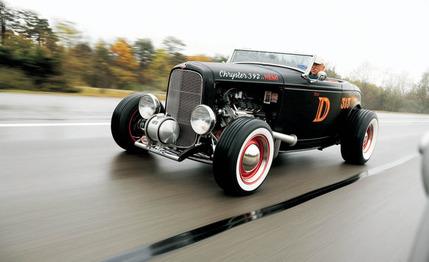
 Specialty File
Specialty File
There are two kinds of car guys: those who get it with hot rods and those whose eyes glaze over. Chris Baum definitely gets it; you see his vision on these pages. Your author feels his pulse quicken, but editor-in-chief Csaba Csere doesn’t get even the faintest whiff.
Let’s chew on the obvious. This is a deuce highboy roadster, code for a 1932 Ford with the fenders tossed but the roadster body still high atop the frame just where ol’ Henry put it. It’s a traditional form, the archetypal hot rod, the basic unit of post–World War II, Southern California, returning-serviceman car exuberance. A roadster was light, and the rodders made it lighter still by throwing away all the nonessentials. Then they did their homemade best with the flathead
V-8s and looked for opponents on the road or on California’s dry lakes.
That was 60-some years ago, and the form has constantly evolved since. Baum’s deuce relives the mood of 1960, give or take, about when Elvis was getting out of the Army. A 392 Hemi was the throw-down motor of the day, white walls were narrowing but still mandatory for style, and Indian blankets on the seats were over if not quite forgotten, an artifact of the improvised, let’s-get-this-thing-on-the-road urgency of early rod building.
The big difference in this new, born-last-year deuce: The improv is factory-made now by the hot-rod “industry.” A builder draws from a bounty of new parts to express what is often a meticulously considered concept. Baum chose as his starting point a Dearborn Deuce convertible body [C/D, June 2005]—a slicked-up replica, in steel, of a ’32 roadster. It has longer doors and more cockpit space than the original and a tilt-up steel tonneau to cover the folded roof.